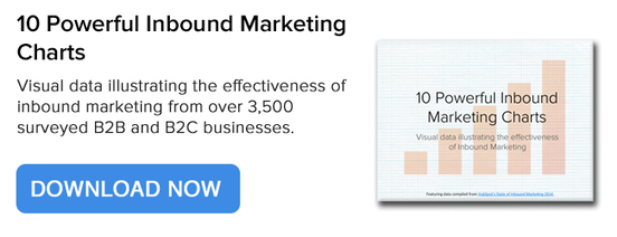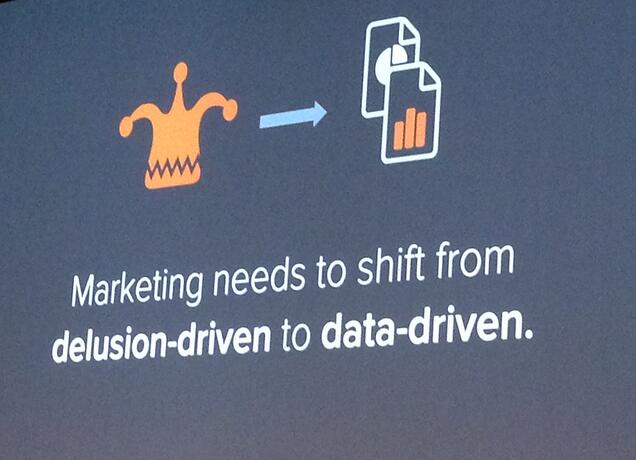
Do you agree that marketing needs to shift from delusion-driven to data-driven? That's what inbound marketing offers businesses. Based on the State of Inbound Marketing 2014, I'm not the only one embracing this transformation.
If you haven't yet made the conversion, it's time to do so. That data-driven approach gets you started on the road to measuring ROI, which in turn gets you much closer to achieving it. To inspire you, here are highlights from the 2014 State of Inbound.
This report is the 6th annual study on inbound marketing. (Here are Highlights From the State of Inbound Marketing 2013.) It includes feedback from 3570 respondents 85% of which are doing inbound vs. 60% in 2013. 49% of respondents have a connection to HubSpot, an all-in-one marketing software automation and analytics solution which enables inbound marketing (note: I am a certified HubSpot Partner).
What's different in the State of Inbound Marketing 2014
Perhaps the most profound and exciting observation has to do with inbound going beyond marketing:
“Inbound” is no longer limited to marketing. Businesses now turn to inbound methodologies to power sales (25%) and even customer service (10%). Certainly the marketing use-case remains foremost, but make no mistake: Inbound has become an interdepartmental phenomenon."
(See Smarketing Takes on New Meaning With HubSpot's New Sales Tools.)
Of the six themes which emerged while analyzing the data, the following four were particularly note worthy.

1. Being Data-Driven and Inbound Unlocks ROI; ROI Unlocks Budget.
"If you are running an inbound marketing program and not tracking ROI, you are doing your company – and your career – a disservice because inbound marketers who measure ROI are more than 12 times more likely to be generating a greater as opposed to lower year-over-year return."
"Proving that you are increasing return is important for several reasons, most notably the positive impact it has on budget. No single factor had a greater impact on budget – positive or negative – than did “past success with inbound.” Improving ROI may even safeguard your budget against factors beyond your control, like the economy itself."
From my experience, the more you engage in any kind of marketing with an end goal in mind, the more likely you are to achieve it. If you plan on spending any resources without identifying ahead of time expectations for the investment (e.g., visits to your website, download of an offer, time spent on site, increased engagement, ecommerce sales, etc), chances are high that you won't even come close to achieving any of your goals; you will have wasted valuable resources. According to this study, marketers who measure ROI are 12x more likely to achieve year-over-year ROI growth. Compelling, no?
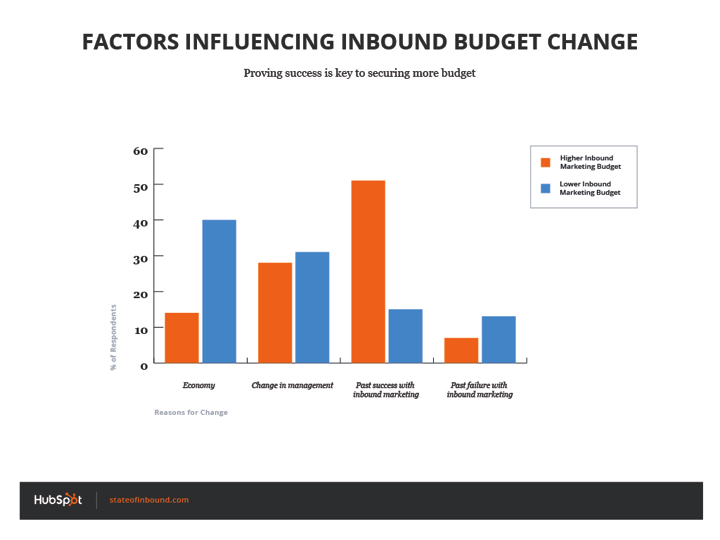
What also happens when you identify goals for marketing programs and campaigns is that you begin to own and shape your future because you have available means for generating traffic to your site, converting visitors into leads and the opportunity to test, analyze and improve. Each success breeds more opportunities for success. There's a pro-active quality to embracing data-driven marketing to generate results rather than in reaction to outside forces. That in turn tends to make you successful - perhaps because you feel a sense of ownership?
Inbound marketing encourages you to ask questions about customers, their buying process, the questions they ask and the resources they need. As you do so, you go beyond your departmental assumptions to include the perspectives of those who interact with customers. That, in turn, leads to jointly identifying marketing and communication tools and campaigns that deliver results.
For some organizations, this collaboration becomes formalized into a Service Level Agreement (SLA). The State of Inbound 2014 says that this tends to happen with marketing budgets greater than $500K. SLAs are a proxy for being analytical and collaborative. As you deliver results, it becomes easier to make a case for additional budget.
2. Getting Found Online Is Priority #1 (and #2 and #3) for High Performers.
Getting found online is critically important. The most effective tool is through remarkable, relevant, content. BTW, did you know that HubSpot has published over 5000 blog articles?
3. Data From Inbound Marketing Facilitates Internal Alignment.
Data is powerful, primarily because it is objective. It's also effective for communicating across departments and experience levels (I love my 10 Visual Reasons for Pursuing Inbound Marketing).
"Data is objective. It’s immune to the feelings and instincts that drove the previous era of “arts and crafts” marketing."
In order to have data that provides you with meaning, you need systems and software solutions which integrate information and allow you to be analytical and look longer term. If you've been immersed in digital and social solutions, you'll have data; the challenge is having meaningful data that allows you to focus and prioritize to drive results.
4. Inbound Isn't Limited to Marketing; It Involves Inbound Selling, Too!
"Inbound is no longer limited to “just” marketing. More than 25% of respondents reported that their organizations’ sales teams practice inbound, and it’s not just lip service."
The inbound methodology makes sense for sales, too. After all, which sales executive wouldn't prefer to have a warm, qualified prospect to talk with in an initial outreach call vs. a totally cold call?
The chart below shows which lead sources have become more important over the last 6 months for inbound and outbound marketers.
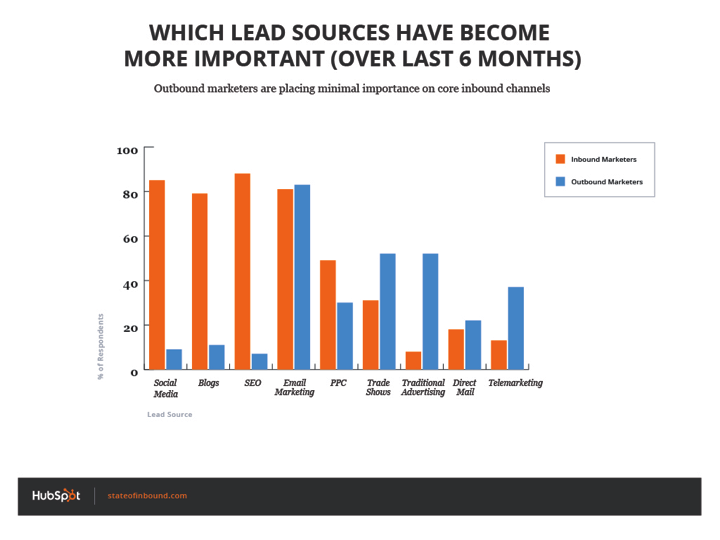
What I find most interesting in the chart above is how inbound and outbound marketers differ significantly in the tactics they focus on for leads - except for email marketing. From what I've observed, inbound email marketing tends to perform better than outbound email marketing.
For that matter, all of the outbound sources can be made more powerful with an inbound slant. For example, attending trade shows and thinking through ways to extend the experience beyond just the trade show event (e.g., Sandy Carter Integrates Social Media Into The Marketing Mix - MProfs B2B Forum).
The report also explored the relationship between content marketing and inbound marketing.Although in differing degrees, content marketing is generally considered a subset of inbound. What do you think?
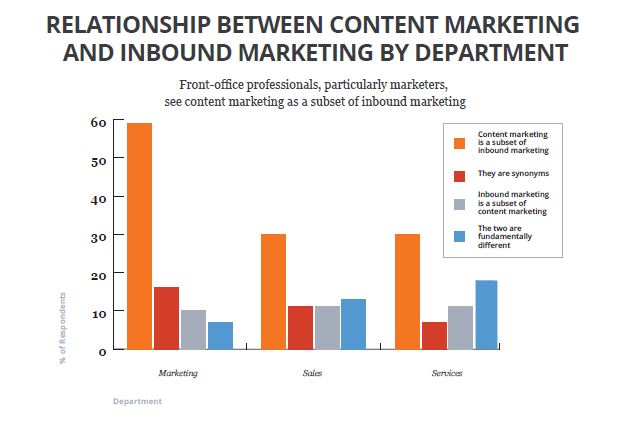
Additional Resources Exploring the State of Inbound Marketing 2014
You'll enjoy these additional resources which explore the State of Inbound Marketing:
- The Difference Between Content Marketing and Inbound Marketing (and Why It Matters)
- 29 Charts & Stats on What Matters Most to Marketers Right Now
- Explore www.stateofinbound.com
What's your reaction to the state of inbound marketing, not to mention data-driven marketing? Are you approaching marketing and sales differently? Is there a place in business for delusion-driven marketing? Let me know in the comments.



